While exploring our backyard in the spring, we noted a 9mm (one-third inch) pot-like nest sticking to a small branch of pacific ninebark (Physocarpus capitatus). We weren’t sure if it was a bee nest or not, so we placed it in a plastic chamber with air holes and left it outside. In late July, a single female resin bee Anthidiellum notatum emerged by chewing a hole in the side of the nest.
Resin bees build their above-ground nests either exclusively of plant resin or a mix of plant resin and stones. These freestanding nests may be attached to a twig, leaf, rock or other surface. The resin is initially pliable but hardens, is waterproof and can withstand a rainy Pacific Northwest winter.
Resin bees are classified in the tribe Anthidiini, and there are several different genera.
Male Anthidiellum are territorial and will patrol a single flower, waiting for a female to arrive. These males will drive off other males that enter their territory. Mating takes place at the flower site.
Female Anthidiellum provision their nest with a ball of pollen, often from plants in the sunflower or pea family. Females lay a single egg and seal the chamber. The chamber has a spout that may allow for air exchange. Mothers will not live to see their offspring. The following year the eggs hatch, and the larvae feed on the pollen ball.
The larvae pupate, and adults emerge by chewing their way out of the resin nests. The resin in the interior of the nest is dark and shiny and forms a waterproof layer.
References
Danforth, B.N., R.L. Minckley, and J.L. Neff. 2019. The Solitary Bees. Princeton University Press.
Burrows, S., C. Ritner, M. Christman, L.R. Spears, A. Smith-Pardo, S. Price, R.A. Ramirez, T. Griswold, and A.J. Redford. 2018. Exotic Bee ID. USDA APHIS Identification Technology Program (ITP) and Utah State University. Fort Collins, CO. [August 2020]
Grigarick, A.A. and L.A. Stange. 1968. The pollen collecting bees of the Anthidiini of California. Bulletin of the California Insect Survey 9:1-113.
Turrell, M.H. 1976. Observations on the mating behavior of Anthidiellum notatum and Anthidiellum perplexum. The Florida Entomologist 59:55-61.
Wilson, J.S. and O. Messinger-Carril. 2016. The Bees in your Backyard. Princeton University PressPhotos.



















